OUR NIG: HARRIET E. WILSON'S AUTO-BIO NOVEL
An intricate, painful tale of Antebellum North's bigotry
Special for THE NEW TIMES HOLLER! By
© Amir Bey, 2020
FEBRUARY 19
From the Bureau of Tell the Truth, Shame the Devil
|
Our Nig, an autobiographical novel by Harriet “Hettie” E. Wilson, was published on September 5, 1859 and rediscovered by Dr. Henry Louis Gates, Jr. in 1981, was the first African American novel published in the United States. The story gives a complex examination of the prejudice that existed in the antebellum North. Wilson's parents, Joshua Green, a Free barrel hooper, out of compassion and growing affection, married her mother Mag, a poor Irish woman - this is Milford, New Hampshire, where interracial marriages were legal. Her father died and she was eventually abandoned. In the story the protagonist Frado, has interracial parents, and is abandoned.
|
Harriet E. Wilson
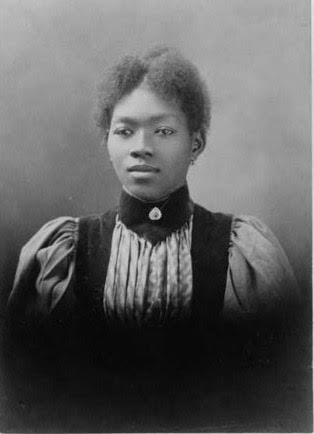 Harriet E. Wilson, date and photographer unknown Harriet E. Wilson, date and photographer unknown
|
This novella-sized story is a multi-faceted gem. While it takes place in New Hampshire and Massachusetts, there are revealing parallels with the South. In Our Nig, Mag, a lonely poor white woman of Irish descent, and Jim, a free “Kind-hearted” African,have two bright and charming children, of which Frado (modeled after the author), the eldest, is gifted with a sense of humor and a spry mind. Wilson, through the contrasting personalities of the Bellmont family, describes the varying degrees of racism and exclusion that was heaped on Frado, creating a wrenching study of the prejudice and hypocrisy that African Americans have continuously been subjected to in the United States.
|
Wilson's natal chart below was done for March 15, 1825 in Milford, New Hampshire, for noon, since there is no known birth time for her. |
March 15, 1825, Milford, New Hampshire |
Harriet "Heddie" Wilson's Natal Chart for Noon
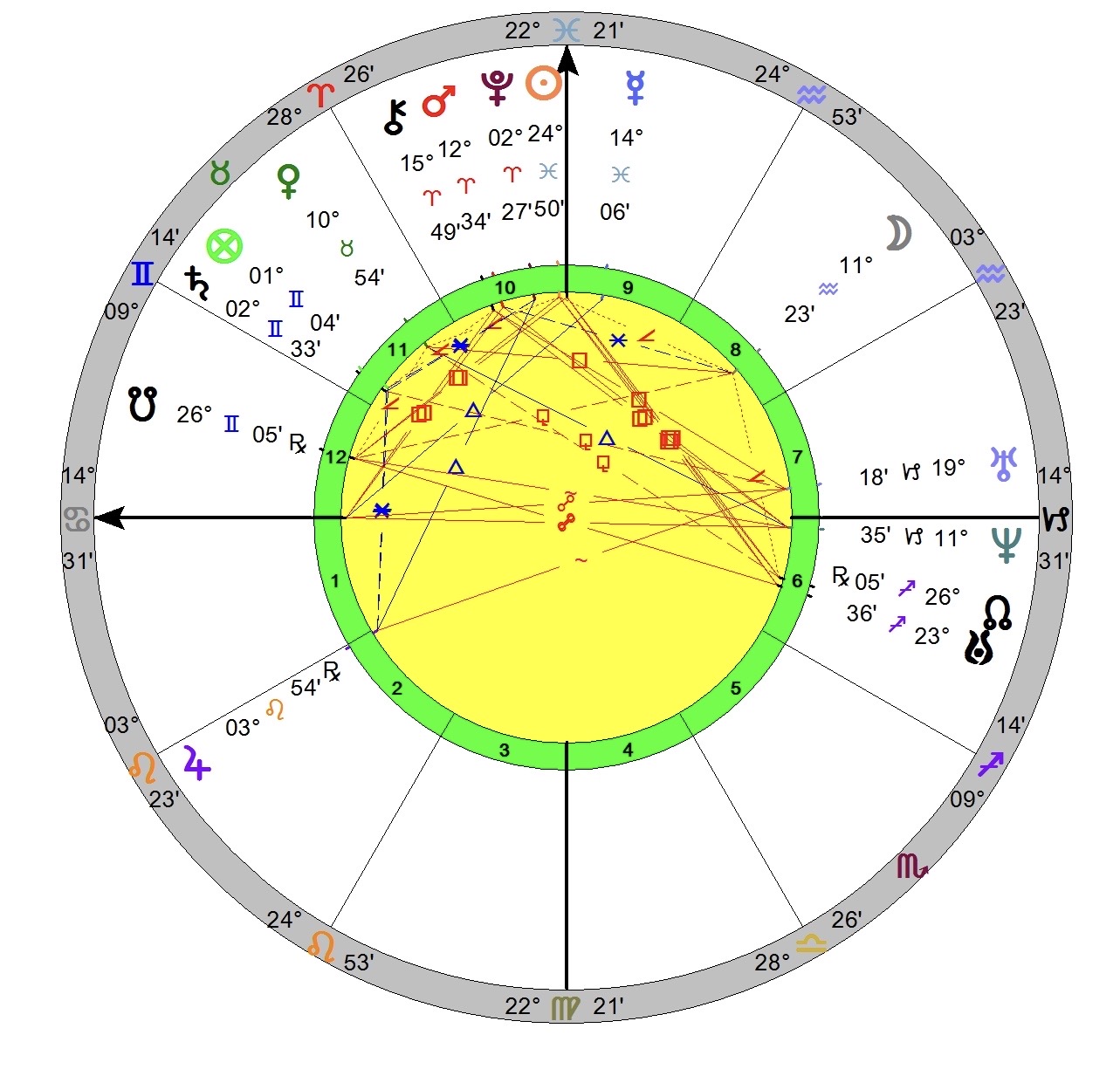
|
In Our Nig, Jim, (modeled after her father Joshua), is a hard-working barrel hooper, who is in partnership with a white man, dies from consumption, what TB was then called. And like Mag’s father before her, her daughter Frado has lost her father at an early age. Mag eventually marries Seth, a white partner of Jim’s, who after a short period suggests that there are too many obstacles for them with two black children and convinces Mag to leave Frado with a wealthy family nearby and they move to another location. She at first objects, out of guilt, but also because Mrs. Bellmont, the woman of said wealthy family, is a “Right she-devil.” However, Seth prevails, and they leave Frado with the Bellmonts, claiming to return that evening, but they never do. The other sibling is obliquely referred to in the book and disappears at this point, and Frado never sees or hears about her mother again. Thus, Frado becomes an indentured servant, as some African Americans became when slavery had ended in the North, as were some whites. This is where Frado’s trials begin. She is severely treated by Mrs. Bellmont and one of the daughters throughout the remainder of her childhood until she was 18.
Through Wilson's pen, the Bellmont family becomes a metaphor illustrating antebellum Northern society. Mrs. Bellmont, the mother, is the status quo, was cruel, and frantically insecure, who at every opportunity burdens Frado with tasks that became increasingly numerous. Frado forced to do the work of several adults to save Mrs. Bellmont money, spending a minimal amount for her upkeep in clothes and food. She beat and tortured the young girl because the tasks were humanly impossible. Through time, this treatment, which included stuffing a piece of wood in her mouth while she was being beaten, took its toll on Frado’s health and spirit. – Until Frado finally tells Mrs. Bellmont that she will not work anymore if she is beaten. Mr. Bellmont, the husband, was acquiescent, who while knowing his wife was wrong, did not contest her except on rare occasions. In those instances, his objections carried weight. He was like a hypocritical authority, who was aware of the moral evil of his wife, yet he was inept and fearful of fighting against her.
There were five adult children: Jane, a kind slightly invalid daughter, brothers Jack and John; these three children felt affection for Frado and were troubled by the treatment their mother gave to her, often rescuing her from horrid situations. The brothers wanted to eventually free her from her enslavement by taking her to live with them. They were not hypocritical or weak like the father, yet they were as unable to change the status quo imposed by Mrs. Bellmont, beyond trying to prevent or otherwise defy the evil that their mother inflicted on Frado. Daughter Mary followed the spirit of her mother, typifying those who unquestionably follow a prevailing regime because it serves their interests and placates their anxieties. Mary and Mrs. Bellmont had an inherent fear and resentment of this young Black girl, who was daring, with a challenging nature that others admired. An older brother James, whose sensibilities were closer to the mother’s as well, lived out of town. Aunt Abbey, Mr. Bellmont’s sister, also felt compassion for Frado, and would comfort her, and fed her full meals, cakes, and other treats that Mrs. Bellmont denied Frado. Aunt Abbey was also hesitant to challenge Mrs. Bellmont, because of the power she wielded in the house – Aunt Abbey lived in another house nearby. Mrs. Bellmont was an implacable negative institution that held sway over compassion and benevolence.
|
HARRIET E. WILSON MONUMENT
Milford, New Hampshire
Fern Cunningham, Sculptor |
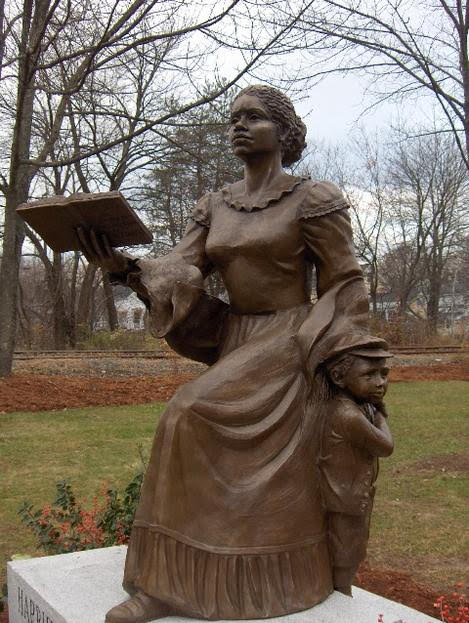
|
Harriet E. Adams Wilson was an intriguing individual. Her father Joshua Green died when she was very young, and her mother abandoned her at the farm of Nehemiah Hayward Jr., who in Our Nig was Mr. Bellmont, a well-to-do Milford farmer.
Her natal planets have Jupiter in Leo was a singleton of a Funnel Pattern, Jupiter the planet of publishing, perspective and visions, ruling her North Node, indicating how Our Nig was a progressive development. She was a “Trance Reader,” spiritual healer, a “clairvoyant physician,” a lecturer, and a member and activist of the Banner of Light, a spiritualist organization. Her Sun and Mercury in Pisces, Moon in Aquarius, describe that, as does her Uranus/Neptune conjunction in Capricor with Saturn in Gemini figure in with those gifts and activities. Saturn in Gemini also describes the dense and profound character of Our Nig. This is not a whimsically romantic 19th Century tale of an orphan, but of an oppressed girl who had few options available to her. It is clear from her writing that while she was literate, she wasn't submerged in the "proper" use of grammar. Instead, she uses capitalization that is personal in style, and plaintive in tone. While reading Our Nig, I found myself wishing I had a time machine to rescue her. She does not have the formal literary style of the African American abolistionist Wllliam Wells Brown, who was able to mix touches of humor with his tragic tales.
These planets and their pattern do not fully describe Wilson’s life. Because there is no precise time, the severity of her experience is only hinted at. Other dates of interest are her two marriages, the first to Thomas M. Wilson, October 6, 1851; their son George died on February 10, 1860, and to John Robison, a younger man, on September 29, 1870. Her first husband Thomas Wilson was a shady character. He claimed to be a runaway slave, touring the abolitionist circuit. However, he had never lived in the South, and only made speeches to satisfy the abolitionists’ hunger for that kind of sensationalism. Wilson abandoned Harriet soon after they married. Pregnant and ill, Harriet Wilson was sent to the Hillsborough County, New Hampshire Poor Farm in Goffstown, New Hampshire, where her only son, George Mason Wilson, was born in 1852, and where he later died. It appears that Thomas Wilson later died at sea as a merchant marine.
While there had been many slave narratives that were previously published decades before, Harriet Wilson created the first autobiographical novel. Clotel, by Willam Wells Brown was published earlier, but in England. Her life began as an orphan, Harriet Adams, who was left by her mother to the Hayward family to be an indentured servant, which was the circumstance of orphans then. In exchange for her labor, she received room and board, but her life was little better than being enslaved if she lived in the South. What is interesting about her story is that although the same attitudes of Southern Whites towards people of African descent existed in New England, the economic and social structures were different. For example, it wasn’t illegal for her to learn to read and write, and her indentured enslavement ended when she was 18, and was not passed onto her son.
The two following charts are for the date that she completed writing Our Nig on August 14, 1859, and when it was published on September 5, 1859.
|
August 14, 1859 Our Nig was written, for Noon, Boston, MA
|
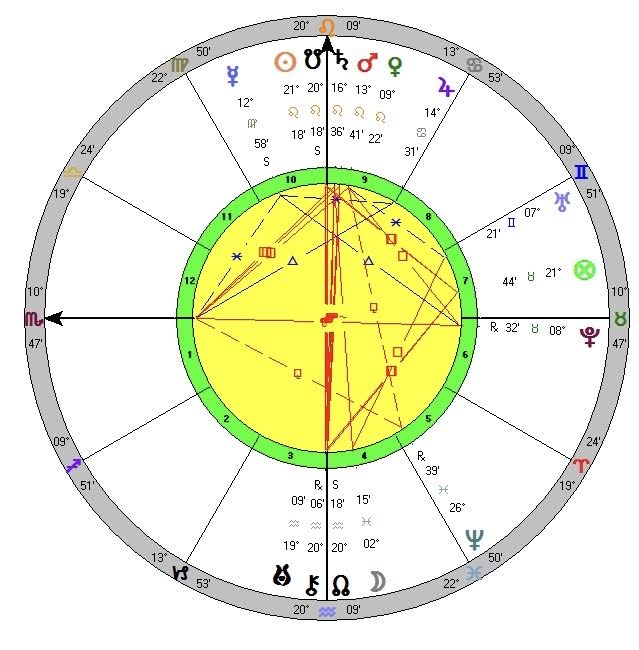
|
For the Our NigWritten Chart, transiting Venus is in a wide conjunctoin with her natal Jupiter in Leo, a planet related to publishing, and viewpoints, with Mars, Saturn, the Sun, and the South Node in the same sign of her natal Jupiter, also in Leo. Neptune closely conjoins Natal Sun in Pisces. Transiting Jupiter at 14° Cancer is opposite her natal Uranus/Neptune midpoint, which implies expansion and opportunity.
As Wilson explains in the preface, writing the book was an attempt to get her son out of the Poor Farm: "Deserted by kindred, disabled by failing health, I am forced to some experiment which shall aid me in maintaining myself and child without extinguishing this feeble life." Sadly, her son died from a fever on February 15, 1860, 6 months after it was written, and, less than six months after the book's publication. It is not known how much time she spent writing the book, or when she began, but the four planets in Leo, the sign of children in the writing chart, is consistent with the motivation to write for her child. The Sun for the writing chart is 21° Leo, opposite the 21° Aquarius Sun at his passing.
September 5, 1859 Our Nig was published, for Noon, Boston, MA
|
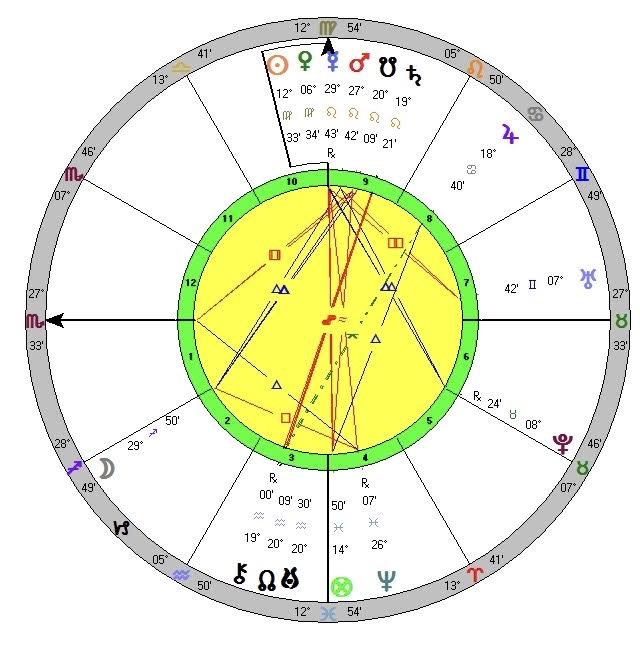
|
For the publishing chart, Neptune’s conjunction with the natal Sun suggests a spiritual or inspired direction for period for her. It also squares her natal Nodal axis, implying that this was a progressive time.
According to biographical sources, Wilson was active in the organization and maintenance at the Children's Progressive Lyceums, a Spiritualist church equivalent to Sunday Schools; she organized Christmas celebrations; she participated in skits and playlets; at meetings she sometime sang as part of a quartet; she was also known for her floral centerpieces and the candies and confectioneries she would make for children.
When she was not pursuing Spiritualistic activities, Hattie Wilson was employed as a nurse and healer ("clairvoyant physician"). She worked as a house servant and a seamstress in households in southern New Hampshire and in central and western Massachusetts. For nearly 20 years from 1879 to 1897, keeping house at a boardinghouse in a two-story lodging. She rented out rooms, collected rents and provided basic maintenance.
On June 28, 1900, Harriett Wilson died in the Quincy Hospital in Quincy, Massachusetts of old age and exhaustion. She was buried in the Cobb family plot in that town's Mount Wollaston Cemetery.
Harriet Wilson Passes, for June 28, 1900, Noon, Quincy, MA
|
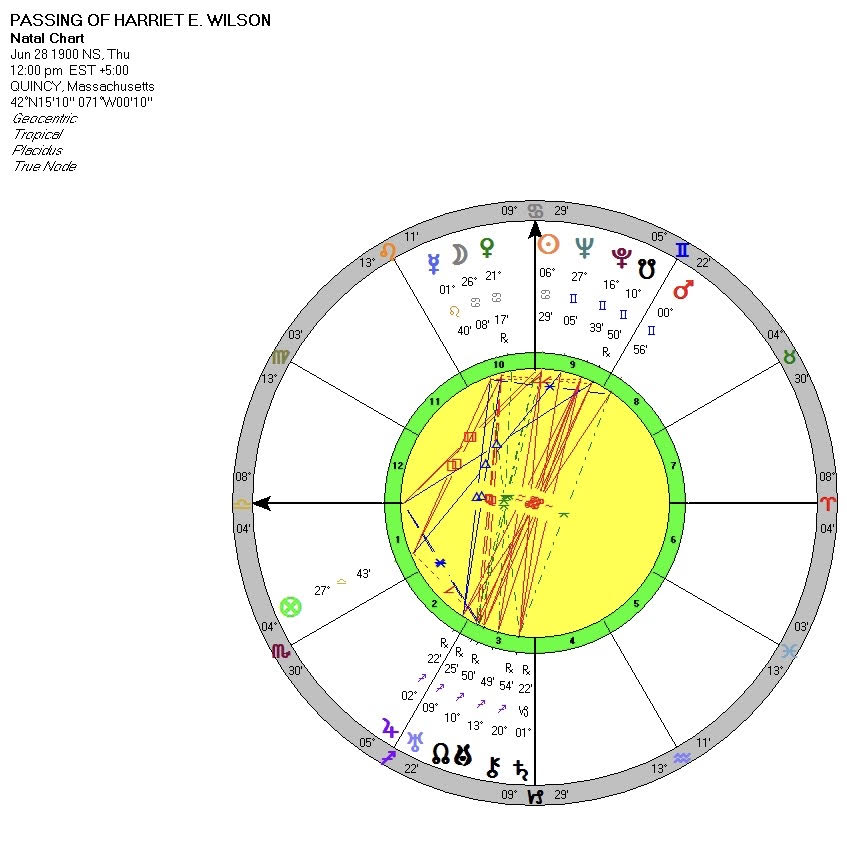
|
From Harriet Wilson’s chart for her passing, (for noon) we see that her natal Saturn at 2° Gemini 35’, is being significantly aspected by a conjunction with Mars at 0 Gemini 56’, and an opposition from Jupiter Rx at 2 Sagittarius 22’. Her cause of death was exhaustion and old age. With Saturn the main natal planet being aspected at her passing, that would describe her health at that time.
|
|
|
|
|
|